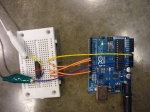This interactive piece is one that involves the discomfort of a communication breakdown. While listeners interact with the piece, they are able to palpably feel awkward through both the audio and the sensory experience of the angled fans.
In this work, a blinking light draws one to pick up the phone. One hears a conversation that is regrettably all too familiar to many a relationship—there is passive aggression, a certain one-sidedness, and an unwillingness to share both information and emotions. While engaging in the audio, a sensory element in the form of a high-powered fan turns on to distract the listener and further complicate the uncomfortable situation. In the end, the listener must choose to continue listening or to avoid the awkwardness of the audio and fan by hanging up the phone.
Arduinos played a large role in the piece. One Arduino controlled the functioning of the audio using a Waveshield. This device reads .wav files off a memory card and transmits them through a speaker. I wired the Waveshield to the actual phone speaker, separated only by the hook switch that hangs up the phone.
Also attached to the hook switch is another Arduino that controls the functioning of the two wall-mounted fans and the blinking led embedded in the side of the phone. The only other piece required is a 220 Ohm resistor to support the led.
The code worked as follows: if the hook switch is depressed (the phone is hung up), the led blinks in a continuous loop. However, if the hook switch changes position (the phone is picked up), the led remains on without blinking and an audio file begins to play once, reset by the hook switch to the beginning of the audio. After an 8 second delay, the two wall-mounted fans turn on and remain on until the phone is hung up. At this juncture, the fans turn off and remain so until the phone is picked up again.
Posted by Emily






